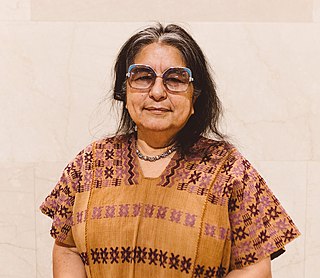Related Research Articles

Yolanda Margarita López was an American painter, printmaker, educator, and film producer. She was known for her Chicana feminist works focusing on the experiences of Mexican-American women, often challenging the ethnic stereotypes associated with them. Lopez was recognized for her series of paintings which re-imagined the image of the Virgen de Guadalupe. Her work is held in several public collections including the Smithsonian American Art Museum, the San Francisco Museum of Modern Art, and the Los Angeles County Museum of Art.

Lola Álvarez Bravo was the first Mexican female photographer and a key figure in the post-revolution Mexican renaissance. Known for her high level of skill in composition, her works were seen by her peers as fine art. She was recognized in 1964 with the Premio José Clemente Orozco, by the State of Jalisco, for her contributions to photography and her efforts to preserve the culture of Mexico. Her works are included in the permanent collections of international museums, including the Museum of Modern Art in New York City.
Ester Hernández is a California Bay Area Chicana visual artist recognized for her prints and pastels focusing on farm worker rights, cultural, political, and Chicana feminist issues.

Carmen Lomas Garza is an Chicana artist and illustrator. She is well known for her paintings, ofrendas and for her papel picado work inspired by her Mexican-American heritage. Her work is a part of the permanent collections of the Smithsonian American Art Museum, the Hirshhorn Museum and Sculpture Garden, the National Museum of Mexican Art, the San Jose Museum of Art, the Mexican Museum, the Pennsylvania Academy of the Fine Arts, and the Oakland Museum of California, among other institutions.

Favianna Rodriguez is an American artist and activist. She has self-identified as queer and Latina with Afro-Peruvian roots. Rodriguez began as a political poster designer in the 1990s in the struggle for racial justice in Oakland, California. R is known for using her art as a tool for activism. Her designs and projects range on a variety of different issues including globalization, immigration, feminism, patriarchy, interdependence, and genetically modified foods. Rodriguez is a co-founder of Presente.org and is the Executive Director of Culture Strike, "a national arts organization that engages artists, writers and performers in migrant rights. "
Amalia Mesa-Bains, is a Chicana curator, author, visual artist, and educator. She is best known for her large-scale installations that reference home altars and ofrendas. Her work engages in a conceptual exploration of Mexican American women's spiritual practices that addresses colonial and imperial histories of display, the recovery of cultural memory, and their roles in identity formation.

The Chicano Art Movement represents groundbreaking movements by Mexican-American artists to establish a unique artistic identity in the United States. Much of the art and the artists creating Chicano Art were heavily influenced by Chicano Movement which began in the 1960s.
Patssi Valdez is an American Chicana artist. She is a founding member of the art collective Asco. Valdez's work represents some of the finest Chicana avant-garde expressionism which includes but not limited to painting, sculpture and fashion design. She lives and works in Los Angeles, California.
Rita Sanchez is an American academic in the field of Chicana/o studies.
Yreina Cervantez is an American artist and Chicana activist who is known for her multimedia painting, murals, and printmaking. She has exhibited nationally and internationally, and her work is in the permanent collections of the Smithsonian American Art Museum, The Mexican Museum, the Los Angeles County Museum, and the Los Angeles Museum of Contemporary Art.

Chicano Art: Resistance and Affirmation was a traveling exhibit of Chicano/a artists which toured the United States from 1990 through 1993. CARA visited ten major cities and featured over 128 individual works by about 180 different Chicano/a artists. The show was also intended to visit Madrid and Mexico City. CARA was the first time a Chicano exhibit received major attention from the press and it was the first exhibit that collaborated between Chicanos and major museums in the U.S. The show was considered a "notable event in the development of Chicano art." Another unique feature of CARA was the "extensive planning" that attempted to be as inclusive as possible and which took place more than five years prior to the opening at Wight Art Gallery.
Santa Barraza is an American mixed-media artist and painter who is well known for her colorful, retablo style painting. A Chicana, Barraza pulls inspiration from her own mestiza ancestry and from pre-Columbian art. Barraza is considered to be an important artist in the Chicano art movement. The first scholarly treatment of a Chicana artist is about her and is called Santa Barraza, Artist of the Borderlands, which describes her life and body of work. Barraza's work is collected by the Mexic-Arte Museum, and other museums around the United States and internationally. She currently lives in Kingsville, Texas.
Celia Álvarez Muñoz is a Chicana mixed-media conceptual artist and photographer based in Arlington, Texas.
Isabel Castro, also known as Isabel Castro-Melendez, is a Mexican American artist born in Mexico City. She was raised and still resides in Los Angeles, California. Aside from being an artist, Castro's career includes curatorial work, education, journalism and photography.

Consuelo Jiménez Underwood is an American fiber artist, known for her pieces that focus on immigration issues. She is an indigenous Chicana currently based in Cupertino, California. As an artist she works with textiles in attempt to unify her American roots with her Mexican Indigenous ones, along with trying to convey the same for other multicultural people.
Suzy González is an American artist and activist, she is known for her paintings and zines that explore social and political issues. She is part of the artist/art curation duo, Dos Mestizx, along with artist Michael Menchaca.
Yolanda González is a Chicana multimedia artist based in Los Angeles. She primarily works in ceramics, drawing, painting, and printmaking.
Angélica Becerra is an activist visual artist who primarily works in watercolor and digital media.
Mari Hernandez is a photographer known for her self-portraits that reflect Chicana cultural identity. She is a co-founder of Más Rudas, a Chicana artist collective. She has had works exhibited at the National Portrait Gallery, Crystal Bridges Museum of American Art, Artpace, and the Galveston Art Center.
Graciela Carrillo is a Chicana artist and muralist in San Francisco and member of the all-female Chicana/Latina artist group Mujeres Muralistas. She is a co-founder of Galería de la Raza, a gallery utilized to showcase the everyday lives of the Chicano community through art during the Chicano Civil Rights movement through the Chicano muralist movement.
References
- ↑ "Daughters of Immigration: Cecilia Alvarez, Tatiana Garmendia, and Blanca Santander | M. Rosetta Hunter Art Gallery". artgallery.seattlecentral.edu. Retrieved March 31, 2020.
- ↑ "Winter/Spring 2001: So to Speak". Archived from the original on March 13, 2005.
- ↑ González, Rigoberto (2005). Antonio's Card / La Tarjeta de Antonio . illustrated by Cecilia Alvarez. CBP. ISBN 978-0-89239-204-9.
- 1 2 Puga, Kristina (May 22, 2012). ""Faces" tell a story at The Mexican Museum". NBC Latino. Retrieved March 31, 2020.
- 1 2 "Cecilia Alvarez | Complete Resume". Evergreen State College Library. 2004. Retrieved March 23, 2015.
- 1 2 3 Alvarez, Cecilia (2008). "Cecilia Alvarez: Biography". Cecilia Alvarez. Retrieved March 18, 2015.
- 1 2 3 Freese, Lauren M. (2013). "Frida Kahlo and Chicana Self-Portraiture: Maya Gonzalez, Yreina D. Cervantez, and Cecilia Alvarez". Theses and Dissertations. University of Iowa. doi:10.17077/etd.iw6kmyzl . Retrieved March 18, 2015.
- 1 2 Ruiz, Vicki L., ed. (2007). Latinas in the United States: A Historical Encyclopedia. Indiana University Press. pp. 42–43. ISBN 978-0-253-11169-2 . Retrieved March 6, 2016.
- 1 2 3 "Chicana Artist : Cecilia Alvarez". www.ceciliaalvarez.com. Retrieved March 31, 2017.
- ↑ "Latina/o Art: Gender in Art". www.umich.edu. Retrieved March 5, 2016.
- 1 2 Puga, Kristina (May 22, 2012). ""Faces" tell a story at The Mexican Museum". NBC Latino. Retrieved March 5, 2016.
- ↑ "Chicano & Latino Artists of the Pacific Northwest at Evergreen | Home". archives.evergreen.edu. Retrieved October 10, 2020.
- ↑ "Artworks by Cecilia Alvarez, in WA's State Art Collection". ArtsWA. Retrieved October 10, 2020.
- ↑ Anonymous (September 21, 2012). "Antonio's Card". Colorín Colorado. Retrieved October 12, 2020.
- ↑ "Cecilia Alvarez | Artist Profile with Bio". www.mutualart.com. Retrieved October 12, 2020.